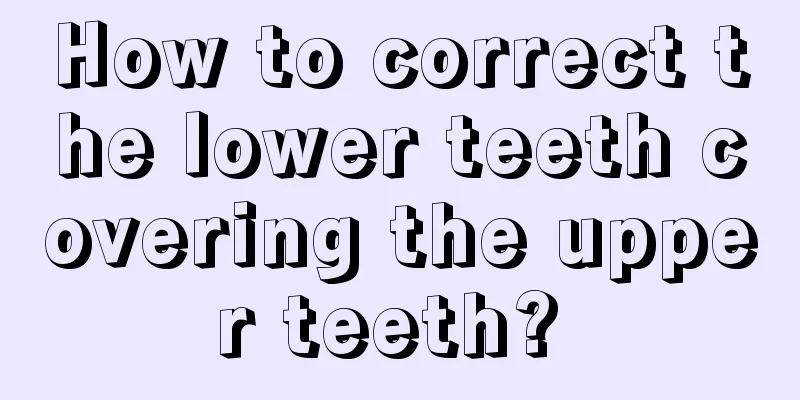How to correct the lower teeth covering the upper teeth?

|
The health of teeth directly affects the health of the body. Good food can be easily absorbed if the teeth are healthy, but if the teeth are not good, the digestion may not be good. Therefore, the health of teeth is very important. The lower teeth covering the upper teeth is called overbite, which is generally divided into two categories. One is dental overbite, which can be corrected, and the other is bony overbite, which is caused by deformity and can be improved through surgical orthodontic surgery. Next, let’s look at the method of correcting the lower teeth covering the upper teeth. 1. Steps Traditional orthodontic treatment is the "iron teeth and steel teeth" correction method we usually see. The correction device is fixed to the teeth with adhesives. Patients cannot take it off or put it on by themselves. It can only be installed and removed and adjusted by the orthodontist. You need to go for a follow-up visit every month, and the doctor will gradually increase the force to move the teeth to the ideal designed state, and the orthodontic work is basically completed. After removing the braces, you will need to wear a retainer for a period of time to consolidate the orthodontic results and prevent recurrence. 2. The effect of simple orthodontic treatment on skeletal overbite is not obvious, and corresponding surgical operation must be performed to achieve satisfactory treatment results. 3. Consult a doctor (you can call or consult online). First, you must determine whether you are suitable for surgical treatment (for example, dentineous overbite does not require surgery), and inquire about prices and other related matters. Learn more about the details, and it is best to consult several hospitals and compare them. Generally speaking, regular hospitals have better quality assurance. 4. Take X-rays of teeth and head bones (panoramic oral film, lateral cephalogram). The purpose is to see the specific condition of your teeth and bones, so as to formulate an accurate surgical plan in the future. 5. To make a dental mold, use a quick-setting glue to put it on your teeth, bite it for 1-2 minutes and then take it out to make a model of your teeth. It is used when formulating the surgical plan and is also for the convenience of comparison during future corrections. 6. The doctor will check your mouth: The doctor will use something to open your mouth to check the situation inside your mouth to see if there is any disease in your mouth to determine whether you are suitable for surgery. 7. Take photos. The doctor will take photos of your teeth from various angles during correction for backup and future comparison. (The only embarrassing thing is that there is a nurse who will stretch your mouth open, exposing such ugly teeth without reservation, and ask you to smile happily in front of everyone. But after you get the braces back from the doctor, there will be a world of difference, and your self-confidence should soar) 8. During the preoperative communication, the doctor will tell you the approximate surgical plan (at this time you need to determine how much alveolar bone you want to recover, depending on your personal preference). 9. During the operation, generally the entire operation is completed within 60 minutes. The operation is performed under local anesthesia. You can feel the doctor moving around next to you. The doctor will talk to you, asking you to clench your teeth, open your mouth, and so on. The surgery is almost over here, and then it’s postoperative care. 2. Diet You can eat some liquid or semi-liquid food at a suitable temperature, such as soup and milk, on the day after the operation, but you cannot rinse your mouth. On the 2nd to 3rd day, you should still drink soup and milk, or some porridge, and rinse your mouth with mouthwash after eating. On the 4th to 7th day, you can eat some food, but you cannot eat anything too hard. Rinse your mouth with mouthwash after eating. The stitches can be removed in 5-7 days (it depends on each individual's situation, generally speaking, they are removed on the fifth day). 3. Notes Return to the hospital for a follow-up checkup within 3 to 6 months and have the fixtures removed. During this period, you can use your teeth normally, rinse or brush your teeth, and maintain oral hygiene. |
<<: How to treat chronic bleeding gums?
>>: Furniture smells? This removes the effect well!
Recommend
Dry cough, runny nose and blood streaks
Sometimes, if the weather is dry, we will actuall...
What medicine can cure cough quickly
Colds, fevers, and coughs are the three most comm...
What causes numbness in finger joints
The problem of numbness in finger joints is often...
Analysis of normal values of 24-hour urine protein quantitative
What is the normal value of 24-hour urine protein...
What is the cause of rectal cancer
Why do so many people still suffer from rectal ca...
Can stage 1 breast cancer be cured?
Stage 1 breast cancer is curable. Through early d...
What is the reason for calf soreness
After regular running exercises, the calves are p...
How to repair sensitive skin, correct skin care routine
Many women have sensitive skin, especially in win...
Is it expensive to treat glioma?
Is the cost of treating glioma high? Glioma is no...
There's blood in my nose and in my throat
Health is a precious asset to people, because it ...
How to wash the hair oil on the pillowcase
In summer, the weather is quite hot. I often wake...
The benefits of eating honey in summer
Honey has high nutritional value and contains man...
The fastest way to make your face sweat_How to make your face sweat
Proper waste elimination is beneficial to the bod...
Two methods for preventing and treating bedsores in patients with colorectal cancer
Colorectal cancer patients are prone to bedsores ...
Is there any harm in mid-term chemotherapy for esophageal cancer?
The earlier esophageal cancer is discovered, the ...









